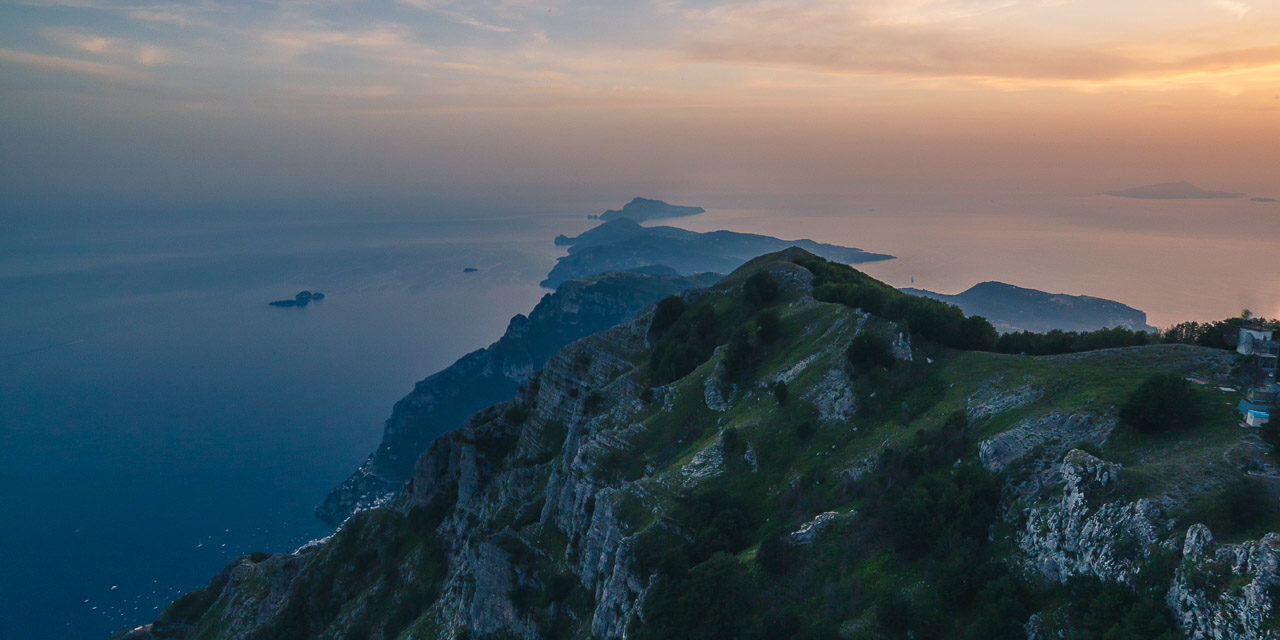Unless you live at the bottom of the Pacific Ocean, you already know about the stunning rock climbing available along the Amalfi Coast, part of the Sorrentine Peninsula, in the South of Italy.
Very well known for its peculiar geography of contrasting mountainous cliffs and a narrow sea, the Amalfi Coast has, over the years, become a luxurious tourist destination with its five-star hotels overlooking the sea, yacht rides, and small cities like Amalfi and Positano decorating the coast.
But in recent years, the Amalfi Coast has also attracted many outdoor enthusiasts, especially hikers. There, hiking lovers can indulge in a huge network of trails known as The Path of the Gods.
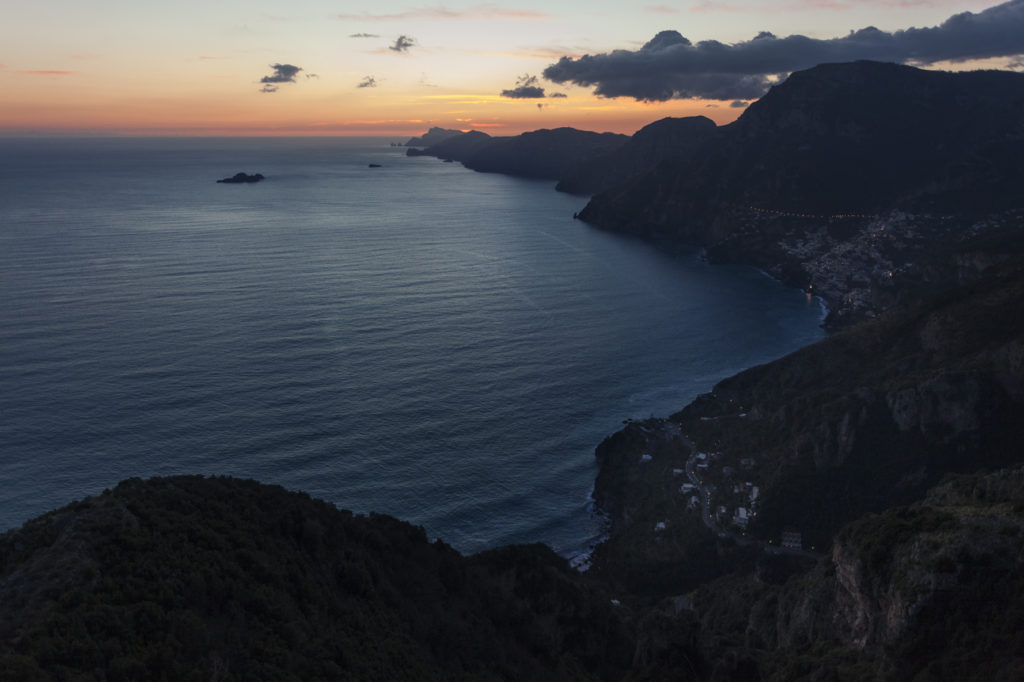
Sunset on the Amalfi Coast. Photo by Francesco Guerra.
What remains a secret is that for the past 20 to 30 years, rock climbing has been developing all over the Sorrentine Peninsula. Thanks to a bunch of climbers who, just out of their passion for the rock, started scouting, cleaning, and bolting an extensive amount of rock in the roughly 100 km (62mi) coast.
Rock climbers can’t help but fall in love with this place. From slab to vertical with small to no foot-holds and a large collection of overhanging muscular climbing, there is something for every climber along the Amalfi Coast. Last but not least, indulging in the local food while watching the sunset transform the crag into a pastel orange/reddish color will make your trip absolutely unforgettable.
The best season to enjoy the Amalfi Coast is, without any doubt, winter. Due to the heavy southern exposure, the crags are perfect to enjoy from late autumn to early spring days, allowing you to climb with just a light t-shirt (or even shirtless) most days.
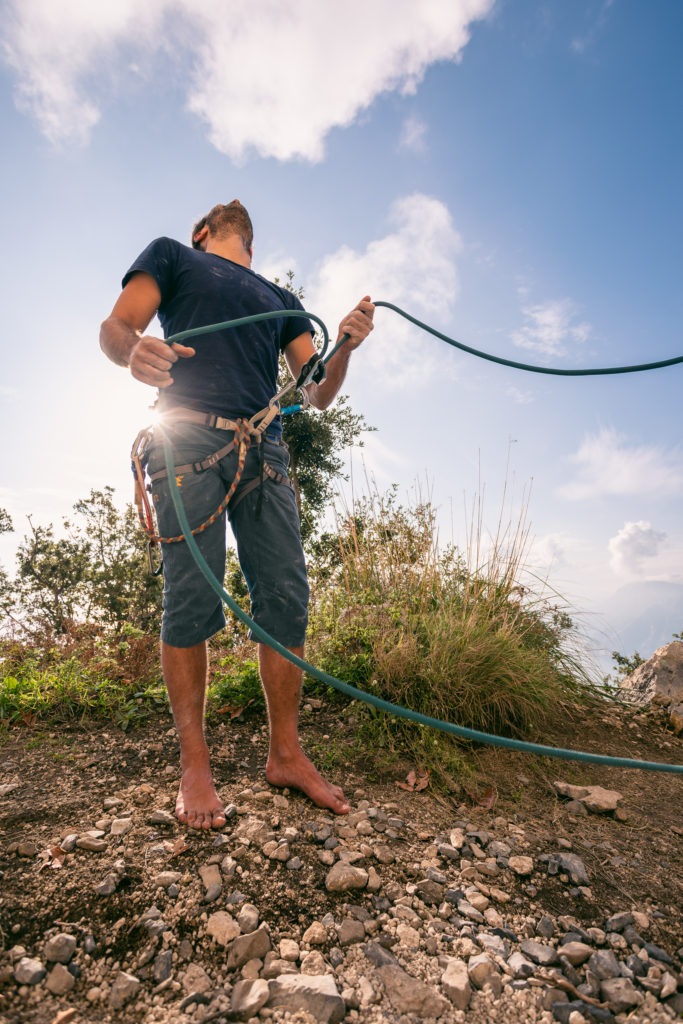
Belaying at Crag of the Gods. Photo by Francesco Guerra.
Specific Description of Climbing Style
Sport climbing reigns at the Amalfi Coast due to the steep vertical development of the peninsula. There are some multi-pitches and also few mountaineering routes (mostly over Positano).
The crags along the peninsula offer a wide variety of styles and grades to suit your tastes: slab, vertical, overhanging, small pockets, short 10 m (32 ft) to long tiring 40 m (130 ft) routes. Grades that vary from 5.6 to 5.13 depending on the crag you choose.
The crags are, starting from the furthest point of the Sorrentine Peninsula:
- Punta Campanella
- Positano
- Falesia degli Dei
- Pizzocorvo
- Punta D’Aglio / Valle delle Ferriere
- Capo d’Orso
- Monte San Liberatore
The crags of Punta Campanella and Monte San Liberatore are actually on the Amalfi Coast, but they are part of the Sorrentine Peninsula and worth including in this guide.
Best Season
For most of the crags, mid-autumn to mid-spring will work perfectly. The southern exposure and the mild temperatures of the Amalfi Coast during wintertime allow climbers, during sunny days, to climb with just a t-shirt and light pants on.
Even if the weather on the Amalfi Coast appears sunny, you should always check the forecast to be sure. All of the crags, except for Punta Campanella, are quite a bit above sea level. The average height is 500 m (1640 ft). This means that a cloudy day can cause temperatures to drop significantly.
Furthermore, the wind can be strong and cold. The wind comes from the south and it can make the air quite damp.
Apart from the inconvenience of occasional bad weather, winter climbing on the Amalfi Coast is practically perfect. Some crags, like Capo D’Orso (the local favorite), do get a bit busy on the weekend.
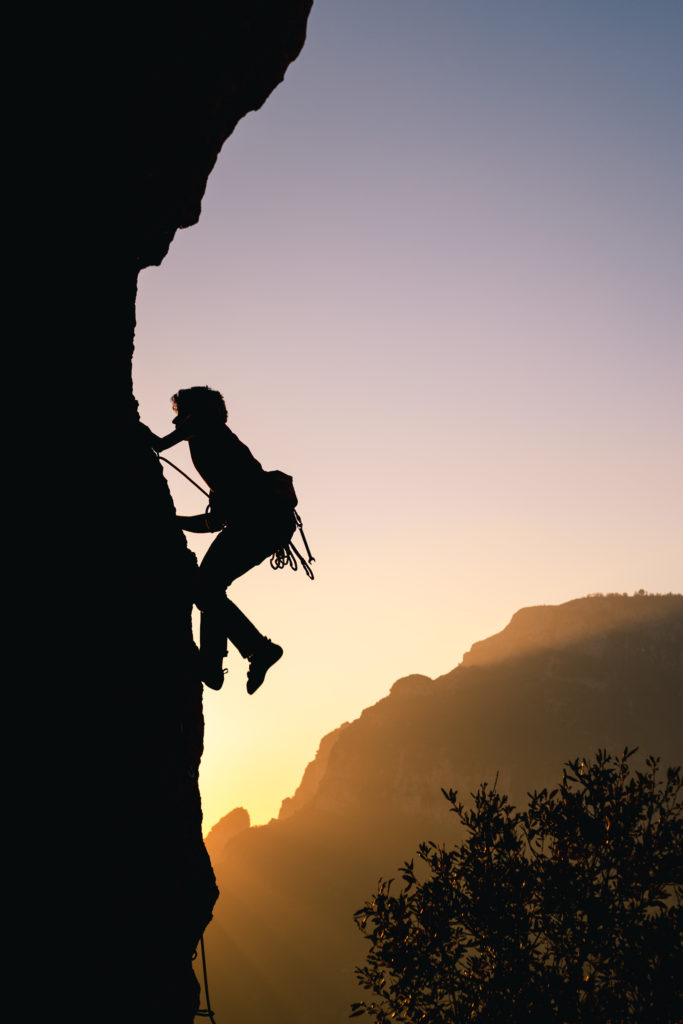
Andrea Sodano on Shining. Photo by Francesco Guerra.
For most crags, climbing in summer is impossible due to the high temperatures. Unless you like climbing before sunrise or after sunset.
The only crags which can be considered to climb in summer are Punta Campanella or Monte San Liberatore. Punta Campanella is near the sea where you can cool off with a swim. Monte San Liberatore has a northern exposure which helps it keep cool. You will still be hot in the summer, but you won’t get roasted by the sun!
Overall, if you want to have the best experience traveling along the Amalfi Coast, climbing and just hanging around, stick to mid-autumn/winter, not just because temperatures won’t make you sweat, but also for the low tourist season. This way you will also enjoy driving on the only road that crosses the entire length of the Amalfi Coast, which gets overly jammed with traffic starting from Easter time until late September.
Transportation
The closest airport to Amalfi Coast is the Naples International Airport, and the second one, if by chance you cannot find a flight, is the Rome airport.
Getting to Amalfi Coast with buses and public transportation can be quite tricky because it is not directly connected to Naples, so you would have to lose a lot of precious time to get trains and buses. My advice is to get there with a rented car so that you will be free to move around without sticking to bus schedules.
In the off-season winter months, you will be able to drive around easily while enjoying the view of the coast. Avoid the mid-spring to late summer months due to the huge amount of tourists that crowd the entire coast every year.
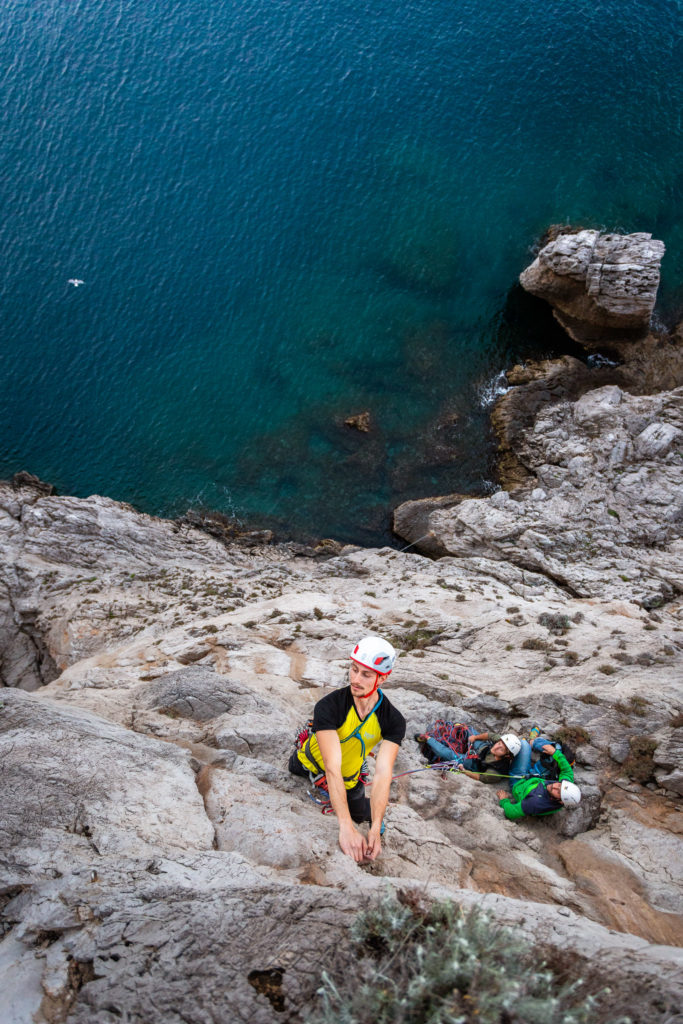
Diego Grassi on Ragno di Mare. Photo by Francesco Guerra.
Climbing Grade Range
Grades vary from 4c (5.6) up to 8b (5.13), and the styles of climbing vary quite a lot. Especially in Positano, where the crags in the area total over 200 bolted routes. In Positano you can find slabs, small footholds, and crimps or overhangs with a wide variety of grades.
Best Local Spot at the Amalfi Coast
There isn’t really a best local spot that climbers prefer over another, because everywhere along the coast you can find good food and drinks.
One piece of advice is: avoid buying stuff in cities directly on the Coast, like in Positano, Amalfi, and Maiori. These cities are very expensive. Get your food in the cities off the coast. In these cities, like Agerola, you will find lower prices for basically everything–and parking will be a lot easier, too.
Punta Campanella, Monte Faito, and Monte San Liberatore crags are all near small villages, so you can just choose the one that inspires you the most and go for it.
In Punta Campanella, there is a local who will insist that you go to his “restaurant.” Don’t fall for it! Just thank him and keep going.. his stuff isn’t that good, and it’s overpriced.
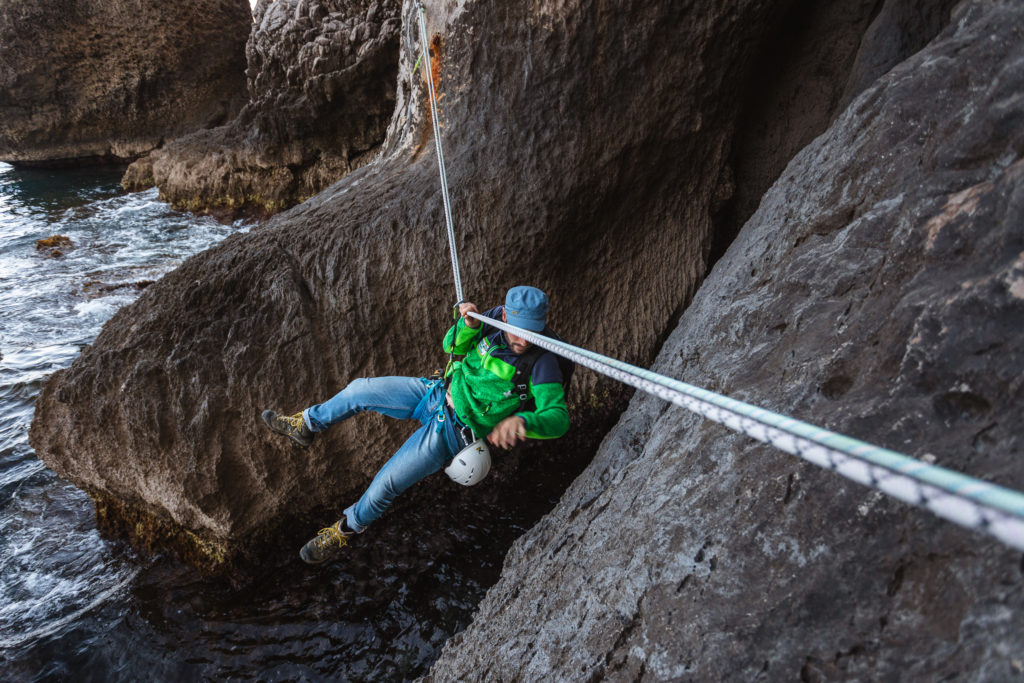
The small traverse to get to the multi-pitch routes on Punta Campanella. Photo by Francesco Guerra.
Best Climbing Areas on the Amalfi Coast
Rock Climbing in Punta Campanella
Known since the ancient Greek/Roman times, this spot is surprisingly beautiful. To get there you will have to hike down a paved path for 30-45 minutes, and then descend into a little passage through the rocks, where you will find yourself on the rocky shore, a few meters away from the sea.
Top Climbs in Punta Campanella
- Machestiamoal Verdon, 6b (5.10d), 38 m (124 ft) – A vertical limestone slab where balance and endurance are the keys to free this long single-pitch route.
- Ragno di Mare, 6a (5.10b) max, 90 m (295 ft) multi-pitch, 4 pitches – This is a classic route accessible to every climber, used also by alpine guides for multi-pitch courses, thanks to its ease. Good foot and handholds along all of the pitches.
- Blu, 6c+ (5.11c) max, 90 m (295 ft) multi-pitch, 4 pitches – This multi-pitch route is a beautiful line that follows the edge of the crag, with grades that will make everything “funnier.”
How Stiff is the Grading?
Grading here is just in the norm, so if you are going to do a 6a (5.10b), expect a full 6a (5.10b).
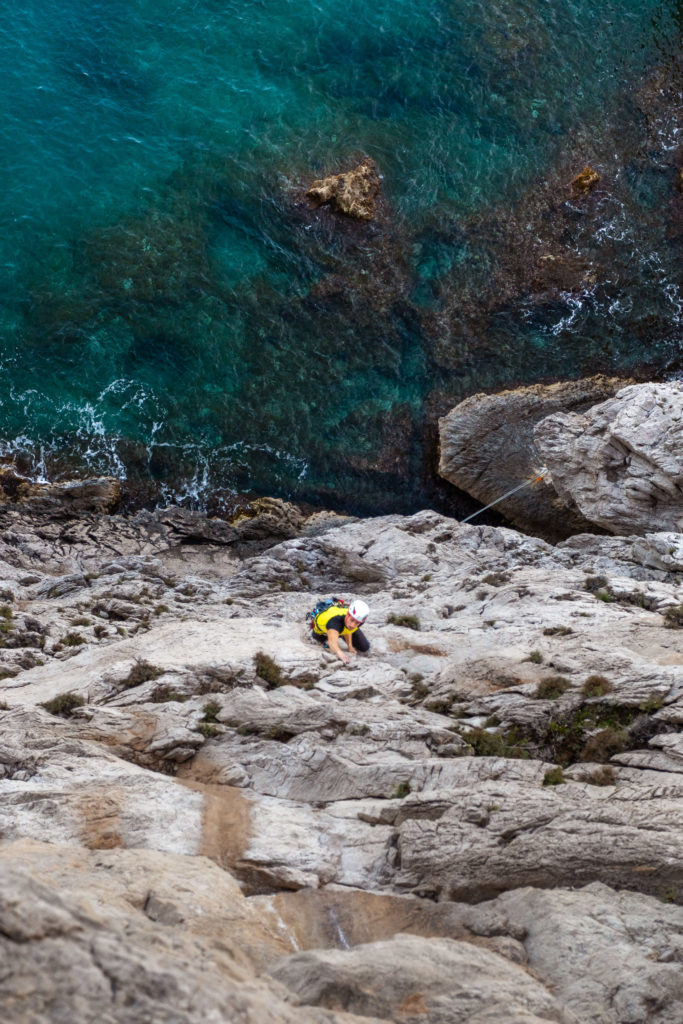
Diego Grassi on Ragno di Mare. Photo by Francesco Guerra.
How to get to Punta Campanella
From Naples, take the motorway to Castellammare di Stabia and follow the signs first to Sorrento, then to Termini. Once in the small square of Termini, park and then follow the signs to Punta Campanella. You’ll have to walk for 30 to 45 minutes before arriving at the lighthouse.
Once you arrive at the lighthouse, you will find, next to the steps, a steep descent down the rocks that will take you to the actual crag.
Where to stay in Punta Campanella
While free camping in Italy isn’t allowed, local climbers do it all the time, without leaving any trace in the morning! In Punta Campanella there’s a lot of space for a comfortable bivouac with a tent–just be aware that winds can get pretty strong.
Rest Day Activities
If you are an experienced climber, it will take you a maximum of 2 days to climb every route in Punta Campanella, unless you also want to climb the three multi-pitches. So, no need to plan for more than a couple days here.
But, if you decide you want to stay longer, then go for a hike on the Baja di Jeranto during your rest day, or go visit the city of Sorrento.
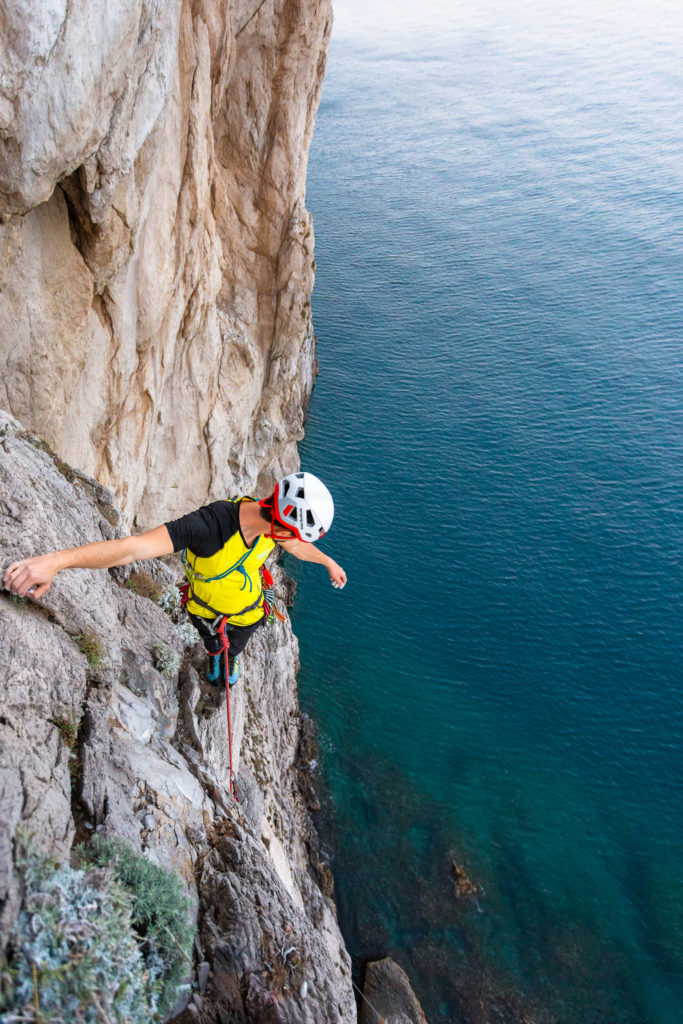
Diego Grassi on Ragno di Mare. Photo by Francesco Guerra.
GPS Coordinates
Parking: 40.590719, 14.339835
Punta Campanella: 40.569990, 14.324955
Sport Climbing crag: 40.569669, 14.325290
Multi-pitch crag: 40.570108, 14.325801
Rock Climbing in Positano
Positano is a special place. The amount of virgin rock still unbolted is just astonishing. If this place would have been in North Italy, USA, or Spain, it would have at least 500 bolted routes rather than the 200 routes it has there now.
There are many different crags in the area, with all the different sport climbing styles you could want (minus crack climbing) and with all the grades you could desire, from 4c (5.6) to 8b (5.13d).
Positano is a paradise.
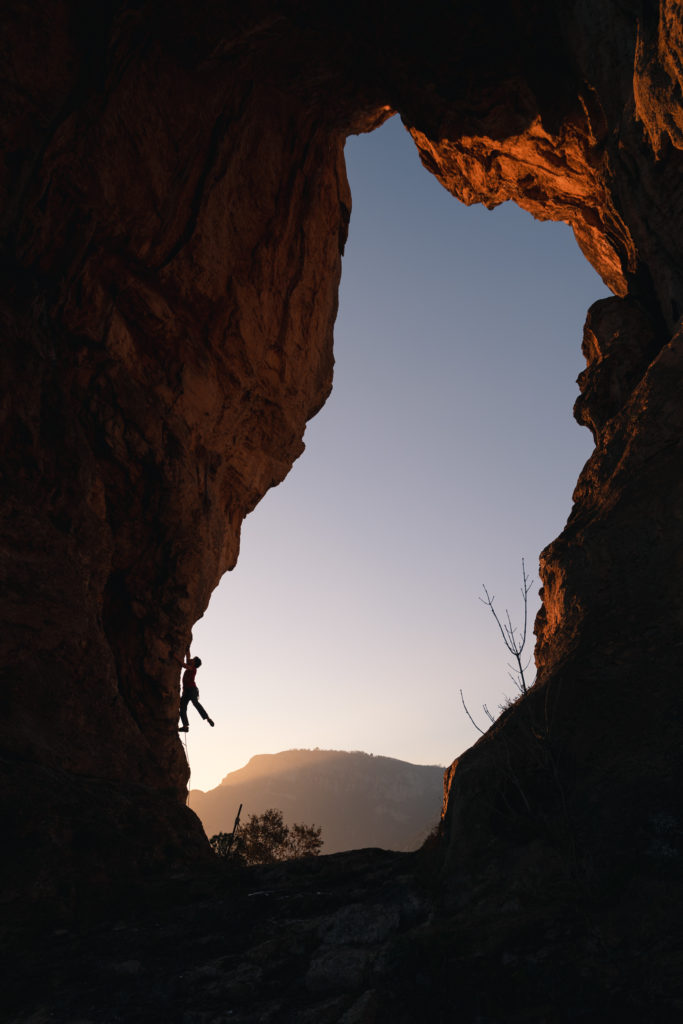
Andrea Sodano on Shining. Photo by Francesco Guerra.
Top Climbs in Positano
Positano has different crags in the area, my advice is to get Malopasso, the official climbing guide of all the Region or this old pdf free guide. While only in Italian, it’s still understandable.
- Paretone crag – Anatema, 7a+ (5.12a), 36 m (118 ft) – As written on the free pdf guide, this route is “various, long, not to be missed.” It follows a continuous pipe-like rock line, so continuity is the key if you don’t want to get pumped!
- Monte Gambera Ovest crag – Il vuoto che rende, 8a (5.13b), 35 m (114 ft) – The name of this route, translated, means “The void that baffles.” It is a long ride in paradise, this route develops on the edge of the rock, and once the first section is done, be aware when you look down. You may find out the meaning behind the name!
- Mirabella crag – Guntabaar L1, 7b (5.12b), 20 m (65 ft) – This is a historic overhanging route, with perfect rock and good holds. This route has also an L2 (second line). Guntabaar L2 is a 30 m (100 ft) 7c+ (5.13a).
- La Selva crag – Maya, 7a (5.11d), 35 m (114 ft) – While the pdf guide describes this route as “one of the most beautiful routes,” I will add that it has a section with sharp edges that aren’t very finger-friendly.
How Stiff is the Grading?
Being so huge and with different styles of climbing, it is quite difficult to say whether the grading is stiff or not. While I find the overhanging grades to be perfect, I feel the slab grading is a bit too stiff, so on a 5.9, you may have some problems doing certain moves.
But that depends on you and your favorite climbing style.
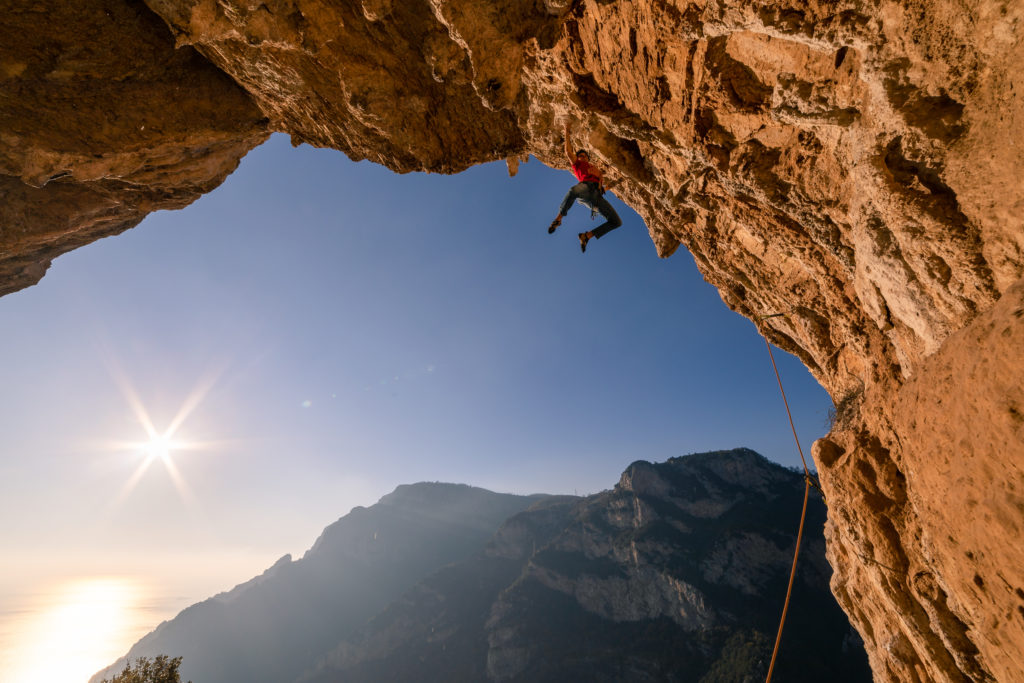
Andrea Sodano on Vento. Photo by Francesco Guerra.
How to get to Positano
From Naples, take the “Salerno-Reggio Calabria” motorway to Castellammare di Stabia, follow the signs first to Sorrento, then the signs to Positano. Once you are on the coast road, keep an eye on the signs, and just at the beginning of Positano take the road to “Montepertuso,” which goes up above Positano.
Park wherever it is possible, but don’t bother the residents by using their private parking.
Be aware that this place is really narrow and parking places are very limited, so you want to be sure to get an early start to the day to find a good parking spot, possibly under the soccer field on the white lines.
Where to Stay in Positano
Positano also offers the opportunity to camp with a tent without anyone bothering you. If you want a good place managed by climbers, then check http://www.associazionelaselva.it/en/
It is managed by Cristiano Bacci and his wife. Cristiano is an experienced climber, and he is one of the main bolters of many of the Positano crags. He will surely be helpful with everything you may need.
Rock Climbing at Capo d’Orso
Placed on a hill on the Coast, Capo d’Orso has one of the best views (if not the best view) of the Amalfi Coast. At sunset, the rock turns gold and then a pastel pink/red. At nightfall, you are surely going to make that moment last forever. Stars above you, a huge cave where you can spend the night, the city lights in the distance: a candidate for the most romantic rock climbing area in the world!
Top Climb at Capo d’Orso
- Anima Migrante, 6a (5.10b), 29 m (98 ft) – Not so difficult for the grade, but indeed a beautiful line that runs up an edge, giving you a privileged sight of Amalfi Coast.
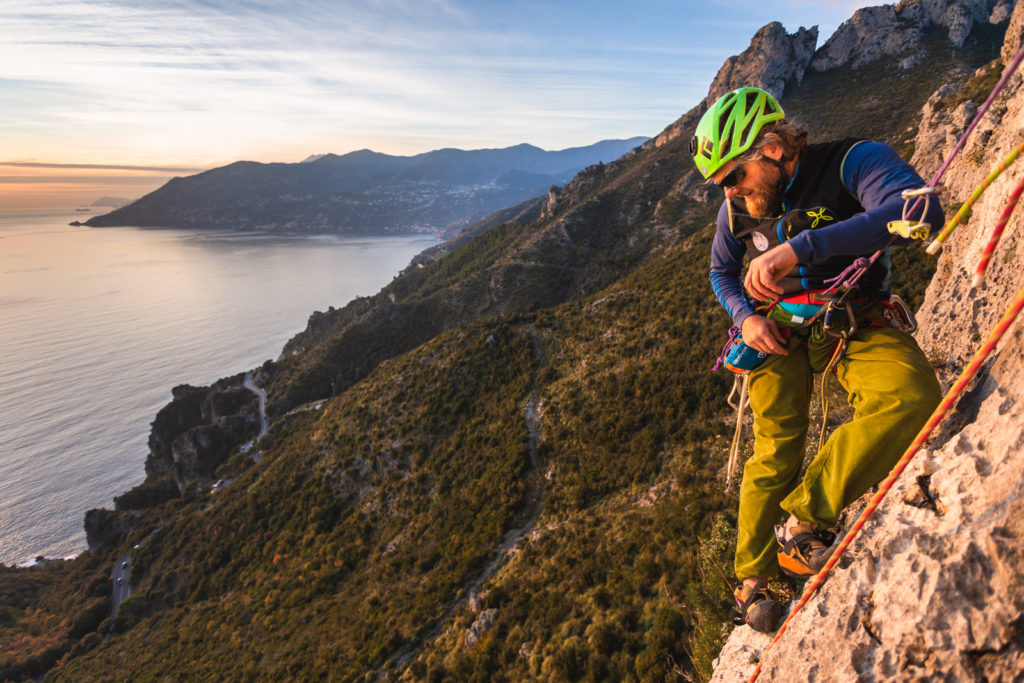
View of Capo d’Orso. Photo by Francesco Guerra.
How Stiff is the Grading?
It really depends on what route you choose, almost all the routes here demand a certain level of endurance, so it will most likely depend on you and your level of endurance training. Overall, the grading isn’t very stiff.
How to get to Capo d’Orso
From Naples, take the motorway “Salerno-Reggio Calabria” and take the Vietri sul Mare exit. Then follow the signs to Maiori. Before getting to Maiori you will pass next to a restaurant, “Il faro di Capo d’Orso.” Pass the restaurant and after a turn, park in one of the pullouts on the road.
Where to Stay at Capo d’Orso
Capo d’Orso crag stands among the fishing village of Erchie and the city of Maiori. Although, as every place on the Amalfi Coast, it can get quite expensive when looking for a Hotels or B&B.
Camping in Capo d’Orso is truly the best option. At the crag, there is a cave where locals often stay for the night with just a sleeping bag and a sleeping pad. There you can take in the amazing view of the Coast at night.
GPS Coordinates
Parking: 40.637247, 14.676425
Starting point of crag approach: 40.637154, 14.677039
Crag: 40.637398, 14.681245
Rock Climbing at Punta d’Aglio / Valle delle Ferriere
Placed in the “Valle delle Ferriere Natural Reserve”, its a place out of a fairytale. Woods, rivers and small falls, and ancient abandoned mills will make you think you have arrived in a long lost city like Eldorado. But just turn your back and look at the rock: if you love slab, search no more, your Eldorado is right there!
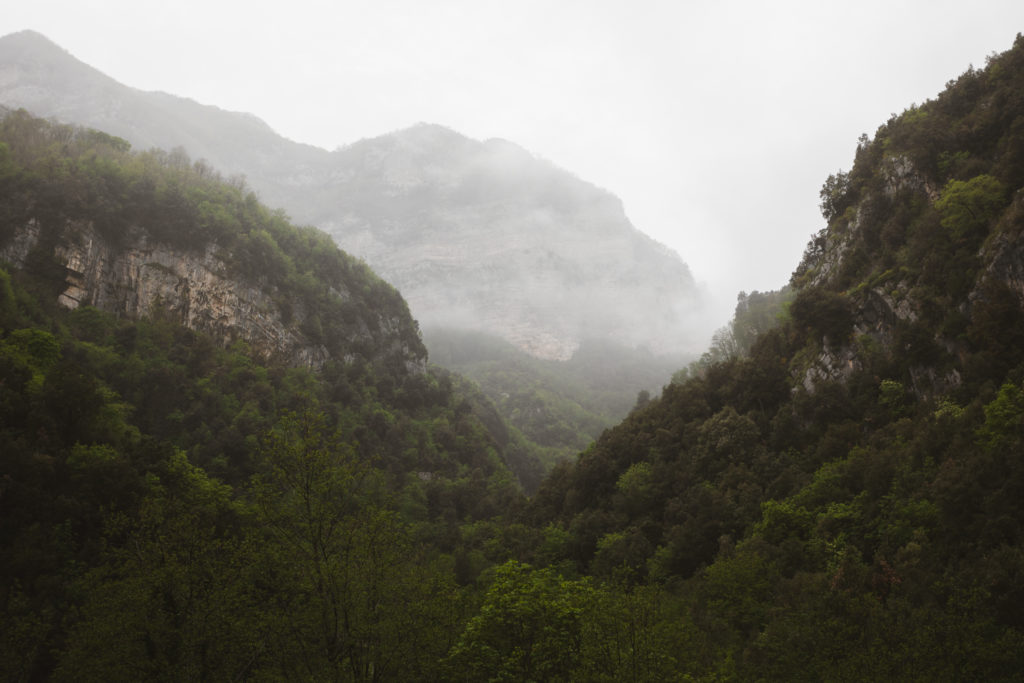
View of Punta d’Aglio Valle delle Ferriere. Photo by Francesco Guerra.
Top Climb
- Topokiller, 7c (5.12d), 29 m (98 ft) – This route has an 82 ft L2 of 5.11a/b.
How Stiff is the Grading?
This crag is mostly composed of a vertical slab with moves that require more mental strength than physical. Small to non-existent footholds, crimps, and sharp edges on the rock will all test your ability to overcome your fear. Grades are honest and not too stiff.
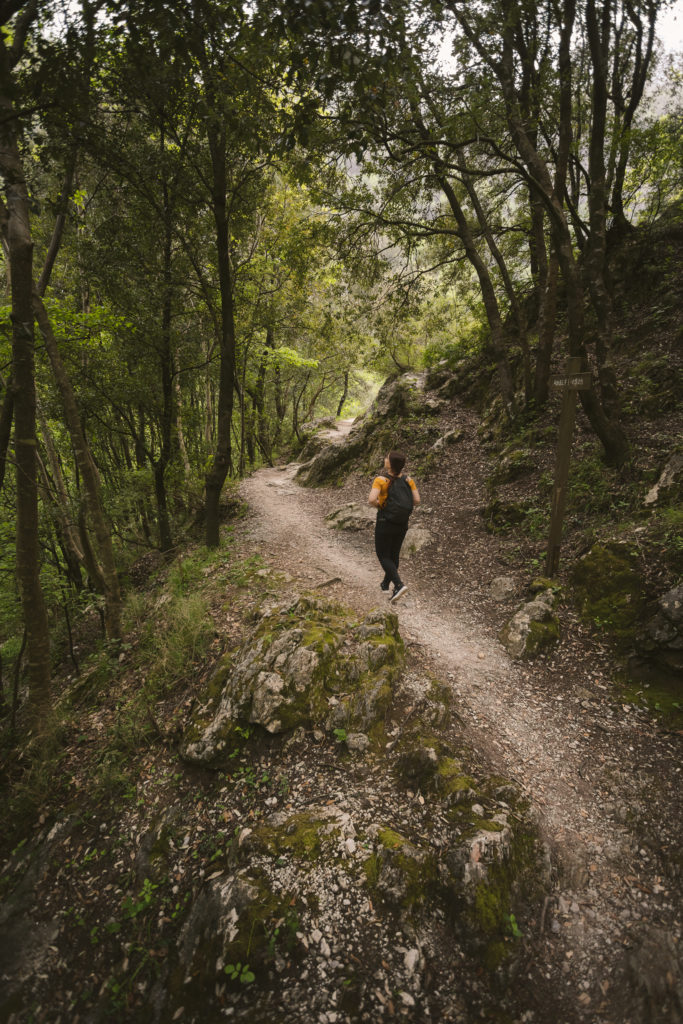
Hiking the Valle Delle Ferriere. Photo by Francesco Guerra.
How to get to Punta D’Aglio / Valle delle Ferriere
From Naples, take the motorway “Salerno-Reggio Calabria” and take the “Angri” exit. Then follow the signs to Corbara and then to Amalfi-Ravello. Proceed on the road until you see the signs to Scala-Pontone. Follow them and park in the square where you see the blue lines. You will have to pay a fee at the parking meter and make sure the ticket is visible inside your car.
Where to Stay
Here there are many B&B, but again, depending on the season, they can be quite expensive. As for camping, you will find good spots to place a tent just next to the crag.
Rest Day Activities
Punta D’Aglio is just over the Valle Delle Ferriere, a beautiful natural park with a river and many little falls all over the forest. Along the path you can see old construction that used to be water mills for the production of paper. This is definitely worth a visit.
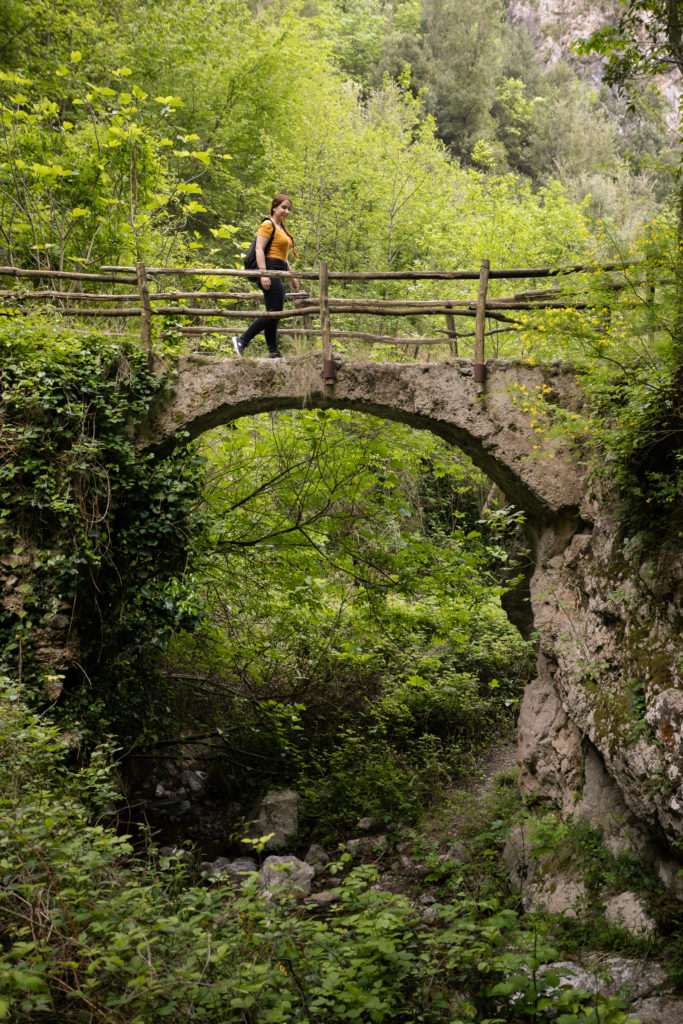
Valle Delle Ferriere bridge. Photo by Francesco Guerra.
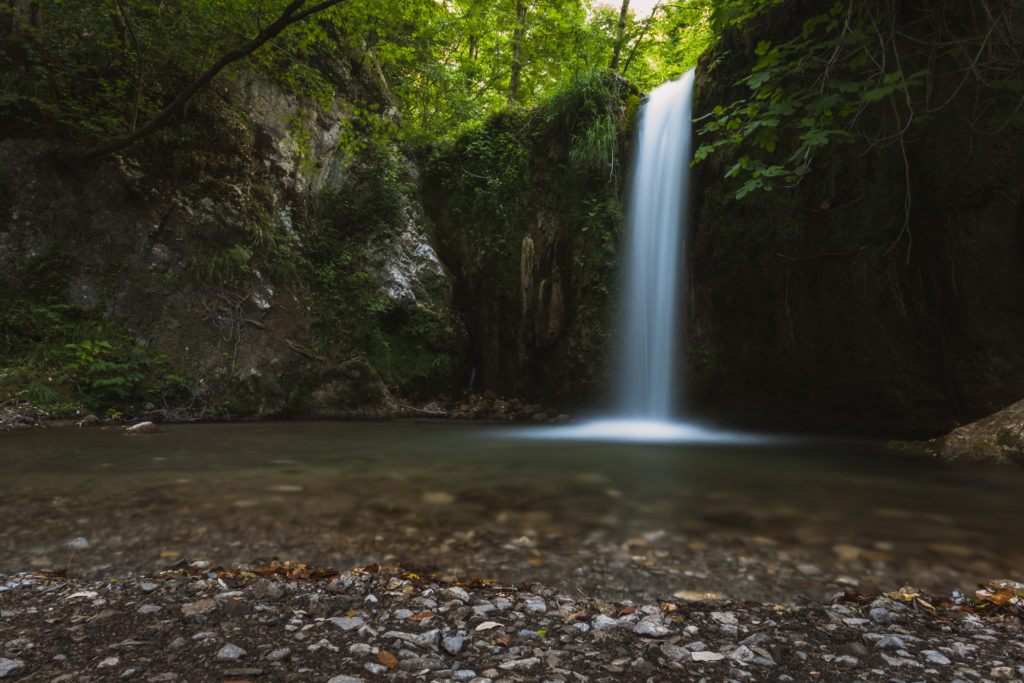
Valle Delle Ferriere falls. Photo by Francesco Guerra.
GPS Coordinates
Park: 40.652165, 14.602279
Crag: 40.650291, 14.593564
Rock Climbing at Pizzocorvo
With only a few steps (the approach is 10 seconds or less), the view on the Coast is amazing, and the climbing is good enough for a good day on a crag. What else can I say?
How Stiff is the Grading?
Apart from the overhanging routes, the grading here is quite soft, and some routes could easily lose half a grade.
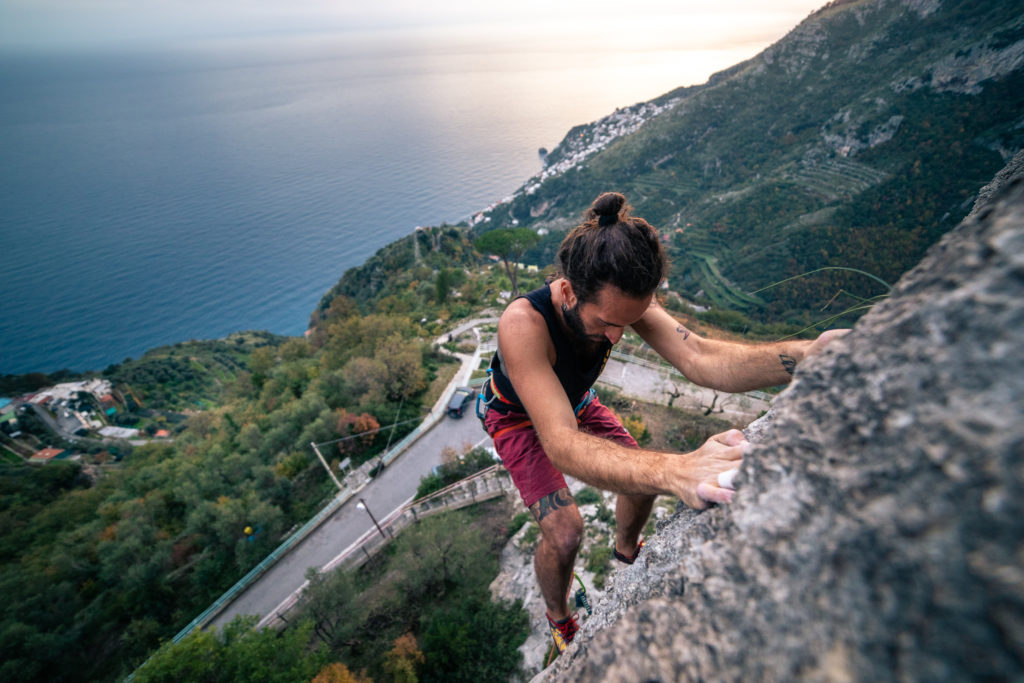
Sergio Morra on Nonno Carrubo. Photo by Francesco Guerra.
Top Climbs at Pizzocorvo
- La Fessura del Criaturo, 5c (5.10a), 20 m (65 ft) – easy route, it has a first section of 4b (5.6), then it becomes fun due to a slightly overhanging crack, which, with 3-4 passages, is done. Then comes the last vertical few feet. This is one of my favorites since it is a great route for a warm-up.
- Lo Spigolo, 6b+ (5.11a), 18 m (59 ft) – A fun, slightly overhanging route with small holds and muscular moves. It shares the same anchor with La Fessura del Criaturo.
- Nonno Carrubo, 7c (5.12d), 25 m (82 ft) – The first half of the route is overhanging, with a boulder section in the middle. Then it keeps going up in an easy slab section to the anchor.
How to get to Pizzocorvo
From Naples, take the “Salerno-Reggio Calabria” motorway to Castellammare di Stabia and follow the signs to Agerola. It is just one windy road that goes up the mountain, so you can’t take a wrong turn. After you arrive in Agerola, keep going to Furore, following the very windy road, which this time will be downhill. At a certain point, you will see a little upward road ahead with a white sign with the writing “S.Alfonso.” Go there and follow the road until it finishes, and park in the clearing.
Take the stairs that go up, and, surprise, you are at the crag!
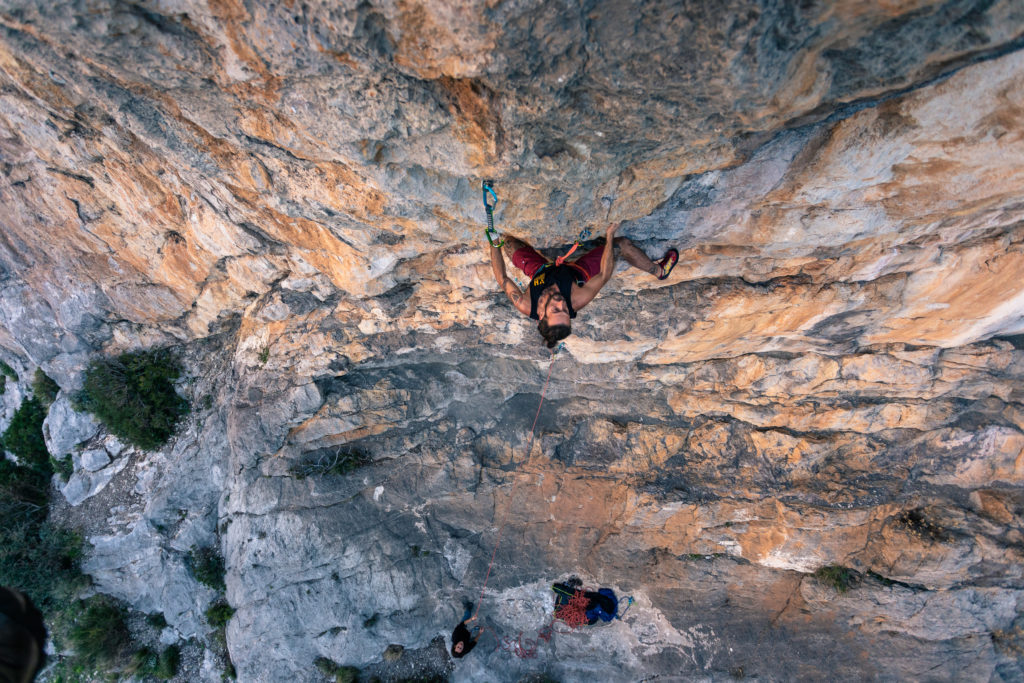
Sergio Morra on Nonno Carrubo. Photo by Francesco Guerra.
Where to Stay in Pizzocorvo
The crag isn’t really big, so I would advise going for just one day and then heading out to another crag. Since the crag is actually placed in a farmer/pastor land that allows climbers to visit, camping really isn’t possible.
GPS Coordinates
Park: 40.619964, 14.542114
Crag: 40.620186, 14.541999
2nd crag, less popular than the first in front of the parking square: 40.623708, 14.539695
Rock Climbing at Falesia Degli Dei
You will have to walk for quite a bit to reach this crag, as it is just at the ¾ of the Path of the Gods, but once you arrive, you will have not only walked with Gods, but you will now climb with them.
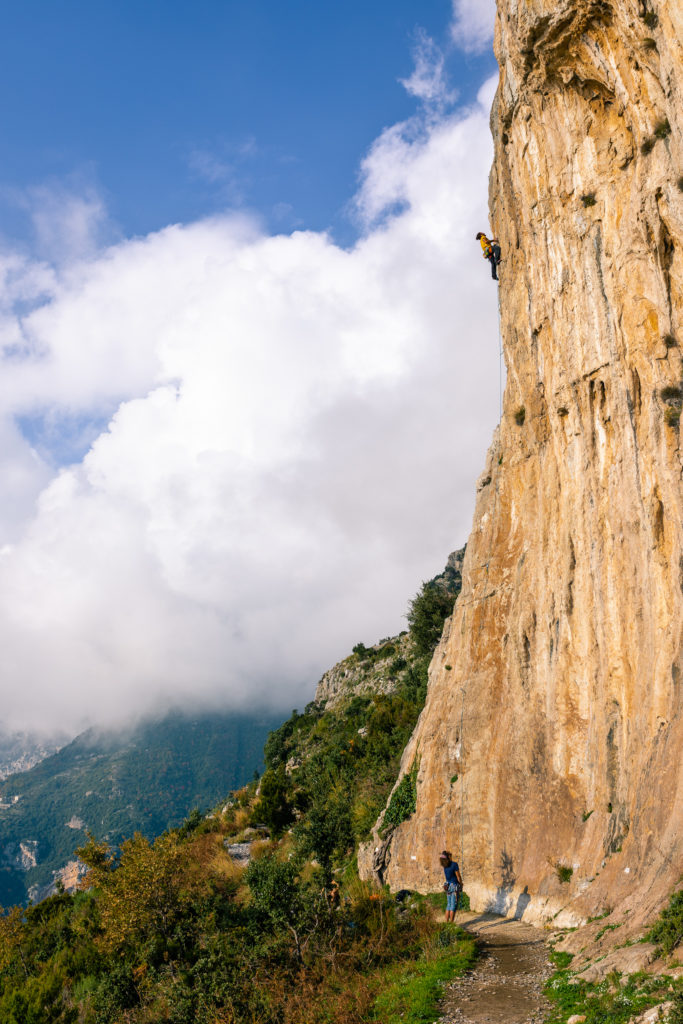
Sergio Morra on Nettuno. Photo by Francesco Guerra.
Top Climbs at Falesia Degli Dei
- Nettuno, 6a+ (5.10c), 32 m (104 ft) – Endurance slab that runs up the edge taking you up to the Gods, giving you a unique and beautiful perspective of the Amalfi Coast.
- Dioniso, 7b (5.12b), 32 m (104 ft) – This one route is very mixed and difficult due to the sections with reeds. The route continues up through a crack section to use your jamming.
- Eros Hard, 7a (5.11d), 26.8 (88 ft) – Very nice route that goes up following the organ pipe-like rock.
- Mi Compro una Scimmia, 6c (5.11b), 23m (75ft) – Endurance route that requires good climbing moves.
- La Striscia di Gaza, 6b (5.10d), 18m (59ft) – Endurance vertical slab with small crimps
How Stiff is the Grading?
Grades are in the norm, but on some slab the psychological factor is very high and demanding, so you may think that the 5.8 you are climbing is actually a 5.10a.
How to get to Falesia Degli Dei
From Naples, take the “Salerno-Reggio Calabria” motorway to Castellammare di Stabia and follow the signs to Agerola. It is just one windy road that goes up the mountain, so you can’t go wrong. Once you are in Agerola, keep going on for few km until you get to Bomerano. Find parking in a free parking lot right after the main square, then follow the signs to the Path of the Gods and hike through the path.
After about 45 minutes you will be at the crag.
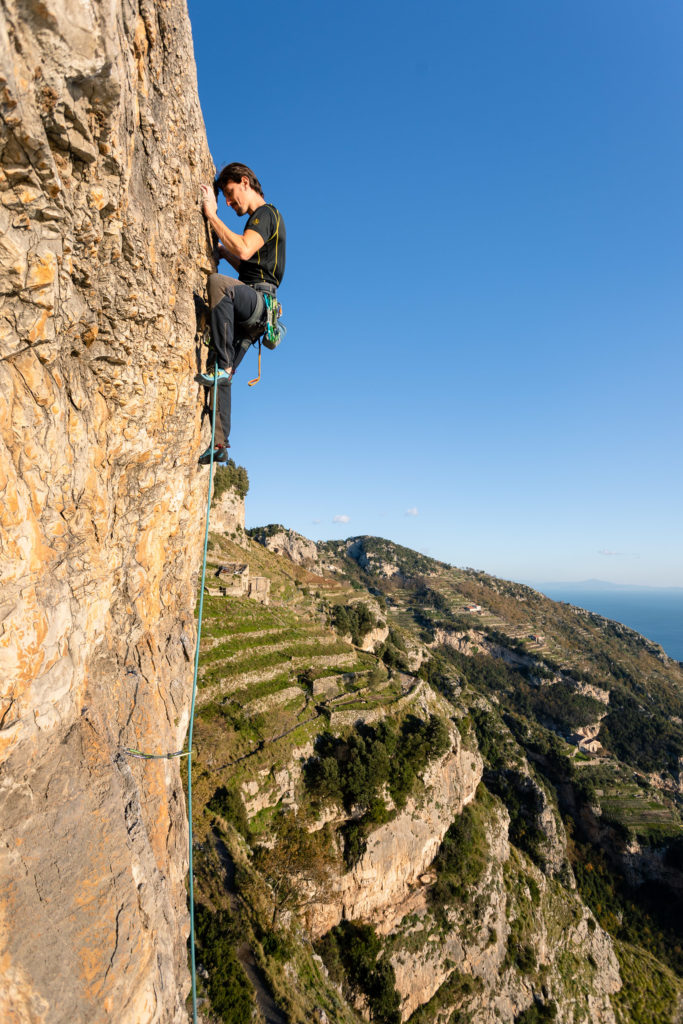
Diego Grassi on an unnamed route. Photo by Francesco Guerra.
Where to Stay in Falesia Degli Dei
Path of the Gods is one of the most famous hikes in Italy, maybe the whole world. Camping there is not possible, because the path is narrow and on the weekends it can get very crowded. Although, it is hiked by many people every day of the year.
Along the path, there is an apartment for overnight rental, Il Canto Degli Dei (this will come with a price) and a B&B Villa Antica Macina: http://www.villaanticamacina.it/
If you find that they’re not worth it, my advice is to get back to Agerola, where there are plenty of cheaper places that you can find.
GPS Coordinates
Park: 40.628101, 14.542043
Crag: 40.622151, 14.517982
Rock Climbing at Monte San Liberatore
Surrounded by woods and exposed to the north, this crag is just perfect when the sun is too harsh. The only downside of this crag is that you can clearly hear the noises from the Salerno harbor and from the motorway.
Top Climb
- Lasonil, 5c (5.10a), 25 m (82 ft) – An easy yet beautiful panoramic route that takes on a height. From the anchor, you can see the gulf of Salerno and, when the sky is clear you can see all of the Cilento National Park.
How Stiff is the Grading?
Grading here is a bit softer than other crags, maybe that’s also due to the fact that it is used by many as a “school-crag” where you can more easily become confident on higher grades.
How to get to Monte San Liberatore
From Naples, take the motorway “Salerno-Reggio Calabria” and take the Vietri sul Mare exit. Then follow the blue sign to “Napoli.” After 2 km, you will have to take a small road on the right, following the signs to Alessia. Follow the windy roads to Alessia, and, once in the square of the small town, park wherever is possible.
From there follow the narrow road through the ancient buildings until you’ll find an old mill. From there, you can choose to go up on the left to get to the Chaos crag, or going on the right, you will go to Geko crag, which has few routes, some of them overhanging.
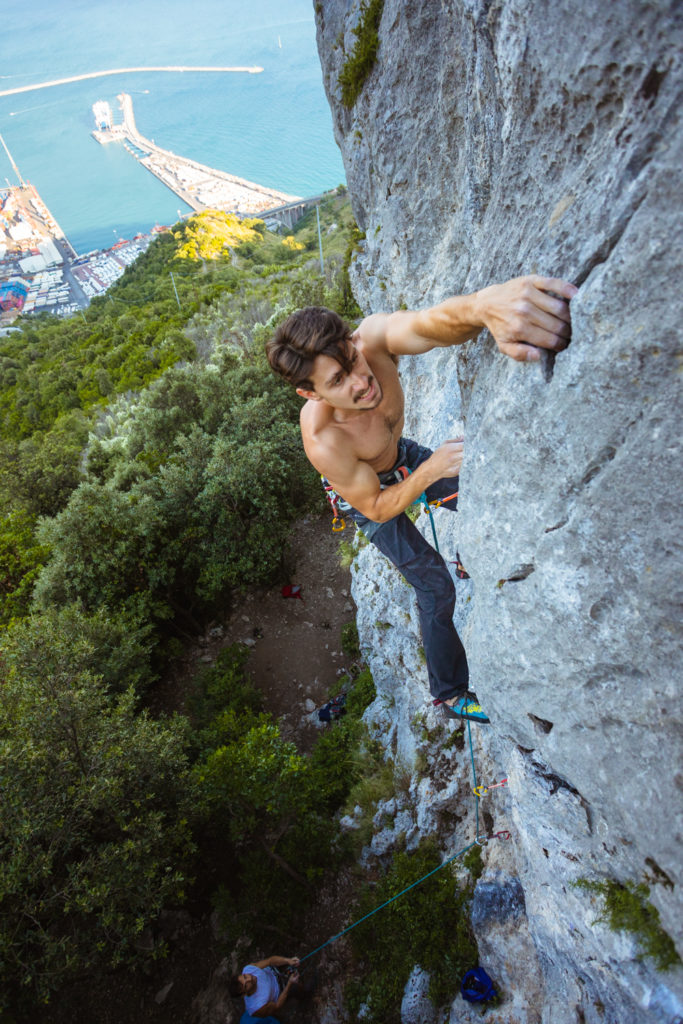
Diego Grassi on Nazca. Photo by Francesco Guerra.
Where to stay in Monte San Liberatore
Up the mountain of San Liberatore is a church and a lot of space. You can easily find a good spot to camp here.
I don’t advise searching for hotels and B&B in Vietri, as the village is very touristy and expensive. But in the small villages next to the crag, such as Alessia, you may find a good B&B or apartment for nightly rental at a reasonable price.
Rest Day Activities
Visiting Vietri Sul Mare and Marina di Vietri, on the coast, will absolutely make your day. Take a walk on the roads, explore the narrow alleys, and get stunned by how everything is decorated with beautifully ornate motifs and ceramics of all sizes and measures.
GPS Coordinates
Where to turn: 40.689400, 14.719581
Park: 40.685598, 14.732475
Chaos Crag: 40.678920, 14.730658
Geko Crag: 40.678546, 14.725236
Rest DayActivities for the Amalfi Coast area
Since many places on the coast are quite close to each other as the crow flies, the rest day activities are almost the same for every one of them. You may visit the beautiful cities of Positano, Amalfi, Ravello, get lost in the alleys of the small village of Erchie, or take a swim on the beach (if it’s warm enough).
If you are just about the outdoors, there are a hundred well-beaten hikes you can take. Take the most famous Path of the Gods to hike to the highest point of the Coast, Monte San Michele (known also as Monte Molare. Its humble 4737 feet is the highest point of the Sorrentine Peninsula and all of the Naples province.
Amalfi Coast’s Best Kept Secret
Amalfi Coast has been a huge place for tourism for a long time now. Meaning that they discovered every cave at sea level and every rock. The only secret (that isn’t really a secret) is: if you are a bolter and you want to create your legacy, Amalfi Coast, especially Positano, can totally be your thing due to the amount of untouched rock.
Climbing Guides for the Amalfi Coast
The official climbing guide of Amalfi Coast and all of the Campania region is published by Versante Sud and written by the alpine guide Oreste Bottiglieri.
You can find it here: https://www.versantesud.it/prodotto/malopasso-arrampicate-campania/
Other Beta
When it comes to buying food and beverages, go to the small grocery shops, instead of big markets. They have what you need, and most products such as cheese, bread, and sausages are made locally. You will spend less and will help the local economy.
Now to You
Moja Gear’s destination guides are only made possible through the feedback from climbers like yourself. Are we missing some beta? Have anything extra to share? Leave your feedback in the comments below.
Have your own destination beta? Submit a destination today.
Related posts:
- Destination Guide: Leavenworth, WA
- Destination Guide: Bishop, CA
- Destination Guide: Squamish, BC
- Moja Gear’s Best Rock Climbing Gear Deals on the Internet

